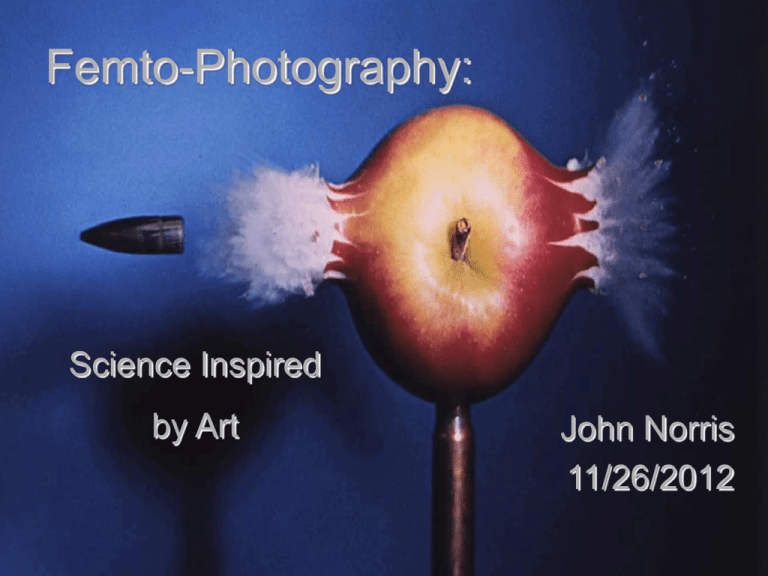Femto Photography (ppt).
advertisement

Femto-Photography: Science Inspired by Art John Norris 11/26/2012 What is Femto-Photography? Ultra high-speed photography Can capture light (photon packets) in motion similar to bullets in traditional high speed cameras Current resolution capability is ≈ 1.7 ps 1 picosecond = One trillionth of a second 1,000,000,000 ps in a second Resultant frame rate: ≈ 5E11 fps (0.5 trillion frames / second) Light sources have extraordinarily small pulse durations Range in magnitude from 10 – 100 fs 1 femtosecond = 1 quadrillionth of a second That means there is 1,000,000,000,000,000 fs in a second! How Is It Done? Many Pre-existing Techniques Pulsing light source Titanium-Sapphire laser Directed to target via mirrors “Streak” camera LiDAR Optical Coherence Tomography Not an actual camera Scans very narrow sliver of target field Several rotating mirrors direct photons to lens Captures roughly a 1-D movie each scan Computer reconstructed “average” of millions of scans Improvement over other techniques Captures ballistic and Indirectly reflected photons Pump Laser Titanium-doped Sapphire Target Field Traditional Camera Laser Beam Reflector Field Scanning Mirrors Who Is Doing It? Research group at MIT: Ramesh Raskar, Associate Professor, MIT Media Lab; Project Director Andreas Velten, Postdoctoral Associate, MIT Media Lab Moungi G. Bawendi, Professor, Dept of Chemistry, MIT Everett Lawson, MIT Media Lab Amy Fritz, MIT Media Lab Di Wu, MIT Media Lab and Tsinghua U. Matt O'toole, MIT Media Lab and U. of Toronto Diego Gutierrez, Universidad de Zaragoza Belen Masia, MIT Media Lab and Universidad de Zaragoza Elisa Amoros, Universidad de Zaragoza Other Contributors: (Femto-Photography Members) Nikhil Naik, Otkrist Gupta, Andy Bardagjy, MIT Media Lab Ashok Veeraraghavan, Rice U. Thomas Willwacher, Harvard U. Kavita Bala, Shuang Zhao, Cornell U. Dr.’s Raskar & Velten Other Projects? Many other scientists working in the same field at different institutions Dr. Raskar and team have also contributed to many other projects Portable Projectors Glasses free 3-D displays Femtosecond transient Imaging Research Publications date back to 2008 Fish Tank Things to note: Halo around central pulse Captive photons in container material? Surface reflection Interference Scattering phenomenon Coke Bottle Things to note: Halo around central pulse Light haze trapped in air pockets Label Reflection Impact and scattering phenomenon Reflected “glow” and invisible packets Length of Coke Bottle: ≈ 11 in ≈ 28 ± 1 cm Traversal Time: ≈ 1.245 ± 0.04 ns Frame Rate: (16s video length) ≈ 373 ± 18 billion fps (pretty close) Practicality and Uses Currently quite impractical Limited by scanning rates Size of targets Inability to process target motion Potential uses in the future Medical Imaging Industrial/Scientific Infinitely better than ultrasound Maps how photons scatter volumetrically 3-D color photograph of internals!!!! Non invasive structural testing of materials Defect analysis Consumer Photography Internal Structure Things to note: Non-uniformities Surface Interior Propagation pulsing Optical Illusions Unexpected behaviors Video Contents Rock candy, laser pulse through orange, and reflection off of the corner of a “room” References "Visualizing Light at Trillion FPS, Camera Culture, MIT Media Lab." Visualizing Light at Trillion FPS, Camera Culture, MIT Media Lab. N.p., n.d. Web. 24 Nov. 2012. <http://web.media.mit.edu/~raskar/trillionfps/>. "Streak Camera." Wikipedia. Wikimedia Foundation, 23 Nov. 2012. Web. 24 Nov. 2012. <http://en.wikipedia.org/wiki/Streak_camera>. "Optical Coherence Tomography." Wikipedia. Wikimedia Foundation, 23 Nov. 2012. Web. 24 Nov. 2012. <http://en.wikipedia.org/wiki/Optical_coherence_tomography>. "Ti-sapphire Laser." Wikipedia. Wikimedia Foundation, 11 Dec. 2012. Web. 24 Nov. 2012. <http://en.wikipedia.org/wiki/Ti-sapphire_laser>.